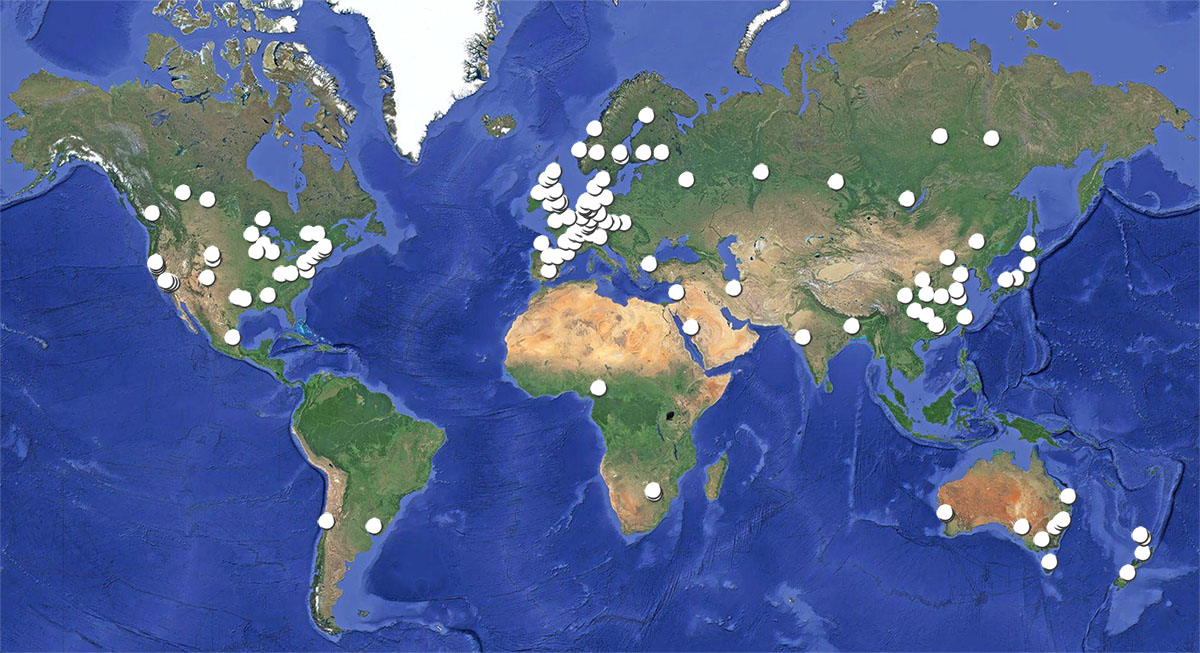International links in CCFS
BACKGROUND
CCFS’ International links provide leverage of intellectual and financial resources on a global scale, and an international network for postgraduate experience. International Partners provide the core of such collaborations. Other international activity includes funded projects and substantial collaborative programs with major exchange-visit programs in France, Norway, Germany, United Kingdom, New Zealand, Canada, USA, Taiwan, Italy, Spain, South Africa, South America, China, Brazil, Mexico, Japan, Thailand and Russia.

FORMAL MEMORANDA OF UNDERSTANDING (MOU)
Formal MOU between international institutions promote the Centre’s collaborative research and facilitate visits by Centre staff and postgraduates as wellas joint PhD research projects. CCFS has agreements with the following international institutions:
- China University of Geosciences (Wuhan) - 2011 (& Cotutelle)
- Constitution of the International University Consortium in Earth Science - 2012
- University of Science and Technology of China, Hefei - 2012 (& Cotutelle)
- Institute of Geology and Geophysics, China University of Geosciences (Beijing) - 2014
- Institute of Tibetan Plateau Research, CAS (Beijing) - 2014
- Helmholtz Centre Potsdam GFZ German Research Centre for Geosciences, Germany - 2015
COTUTELLE MOU
Cotutelle MOU aim to establish deep, continuing relationships with international research universities through joint research candidate supervision. CCFS has agreements with the following international institutions:
- China University of Petroleum, Beijing, China
- Durham University, United Kingdom
- Eötvös Loránd University, Hungary
- Friedrich-Alexander-University of Erlangen, Nuremberg, Germany
- Nanjing University, China
- Pierre and Marie Curie University, PARIS VI
- Peking University, China
- São Paulo University, Brazil
- University of Barcelona, Catalonia, Spain
- Universidad de la Republica, Uruguay
- Université Montpellier 2, France
- Université Paul Sabatier, France
- University Jean Monnet, France
- University of Zaragoza, Spain

CCFS INTERNATIONAL COLLABORATIVE NETWORK
INTERNATIONAL LINKS - 2021 SELECTED HIGHLIGHTS
- A collaborative project between the Institute of Geology and Geophysics, China Academy of Science, Beijing (IGG CAS), CCFS, Geoscience Australia (GA), and ANSIR (Australian facilities for Earth sounding) resulted in a 4-year passive seismological deployment (China-Western Australia Seismic survey - CWAS) along a 900 km profile across Western Australia from Port Hedland to the southwestern border of the Kimberly Craton. 80 broadband seismic stations were established and extended beyond the continent margin in the Canning Basin using ocean-bottom seismometers (CANPASS).
- A collaborative research agreement continued with the China University of Geosciences (Wuhan) with funding by the Chinese Scholarship Council (CSC). This grant provides a living allowance and travel between China and Australia for students and visiting scholars. Students and researchers funded by this project study and work under the project’s aims, integrating geological, geochemical, geophysical and experimental techniques to study the structure, composition, geodynamics and metallogeny of the deep lithosphere and beyond.
- CCFS Director, Professor Sue O’Reilly, is a group leader of UNESCO-IUGS IGCP 662 project aimed at providing insights on current global issues and supported by the International Geoscience Programme (IGCP) (href="https://en.unesco.org/news/new-projects-will-explore-geological-record-support-sustainable-development). IGCP 662: “Orogenic architecture and crustal growth from accretion to collision” aims to conduct comparative studies of several types of orogens (accretionary and collisional) to better understand the dynamics of Earth’s crust, and the genesis and distribution of mineral deposits (metallogenesis). It includes a comparative study of the Central Asian Orogenic Belt (CAOB); one of the world’s largest accretionary orogens spanning six nations and evolving over some 800 million years, the Tethyan orogenic belt; the world’s youngest extensive collisional and metallogenic belt, and other composite orogens. The project includes participants from more than 143 countries with diverse socio-economic and political contexts.
- The UNESCO-IUGS IGCP 648 project “Supercontinent cycles and global geodynamics” continued in 2021. The project brings together a diverse range of geoscience expertise from around the world, including three CCFS CIs, to explore the occurrence and evolution history of supercontinents through time and construct global databases of geotectonics, mineral deposits and the occurrences of past mantle plume events.
- Simon Wilde has continued as director of the International Precambrian Research Center of China, Chinese Academy of Geological Sciences.
- Marco Fiorentini continued international collaborations with:
- University of Milan, Italy: ongoing work with Marilena Moroni and Massimo Tiepolo on the Ivrea Zone (Italy) and the role of volatiles in magmatic systems
- Moscow State University, Russia: ongoing work with Alexey Ariskin on the genesis of Ni-Cu-PGE mineralisation in the Dovyren layered intrusion, Russia
- Siberian Branch of the Russian Academy of Science, Irkutsk, Russia: Ongoing work to establish the nature of the volatiles in the Siberian Traps
- University of Bologna, Italy: ongoing work on the nature of the sulfur cycle in magmatic arcs
- University of Leicester, UK: ongoing work with David Holwell on the Ivrea Zone (Italy), the role of volatiles in magmatic systems, and the Munali Ni-Cu-PGE deposit
- ETH, Switzerland: ongoing work with Andrea Giuliani on metasomatism of the lithospheric mantle
- Tokyo Institute of Technology, Japan: ongoing work with Yuichiro Ueno on the multiple sulfur isotope characterisation of Archean magmatism
Following the sucessful two phases of seismic deployments in the Canning Basin Western Australia, the collaboration with the IGG-CAS moved to the Pilbara region in 2021. This two-year field deployment (pictured below) targets the unique granite domes and greenstone keels in the Archean Pilbara Craton. The new seismic models are expected to shed light onto how early Earth operated in the Vertical Tectonic regime.
IGCP 662 was a co-sponsor for the very successful Session 7: “Lithospheric architecture and deep material probing” at the DEEP 2021 virtual meeting International Symposium on Deep Earth Exploration and Practices held from 26 to 31 October. (see abstracts)
IGCP 662 project information and upcoming events are available from here
IGCP 648 annual workshop was replaced by a Virtual Seminar Series.
For more information visit http://geodynamics.curtin.edu.au/igcp-648/

 ARC Centre of Excellence for Core to Crust Fluid Systems
ARC Centre of Excellence for Core to Crust Fluid Systems